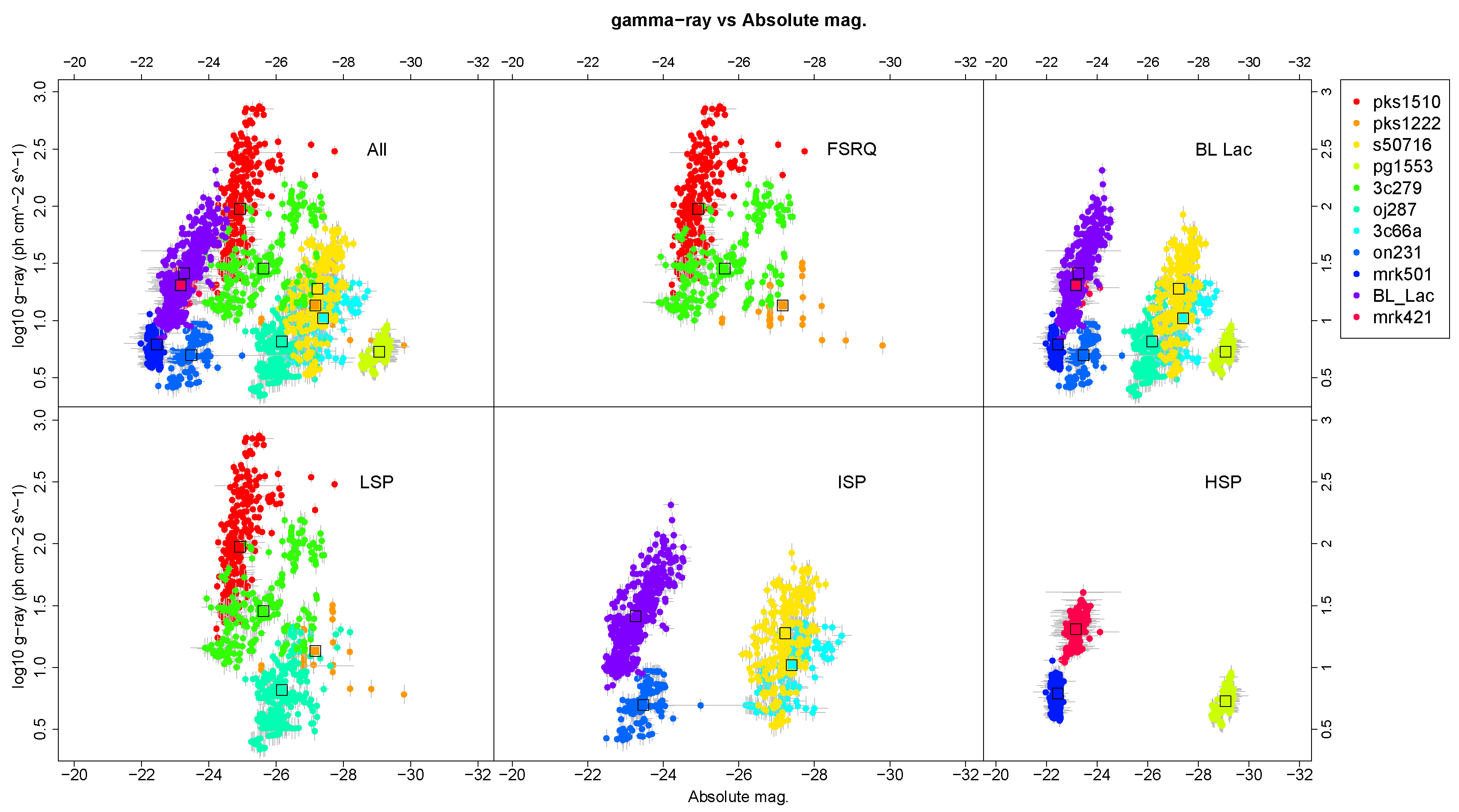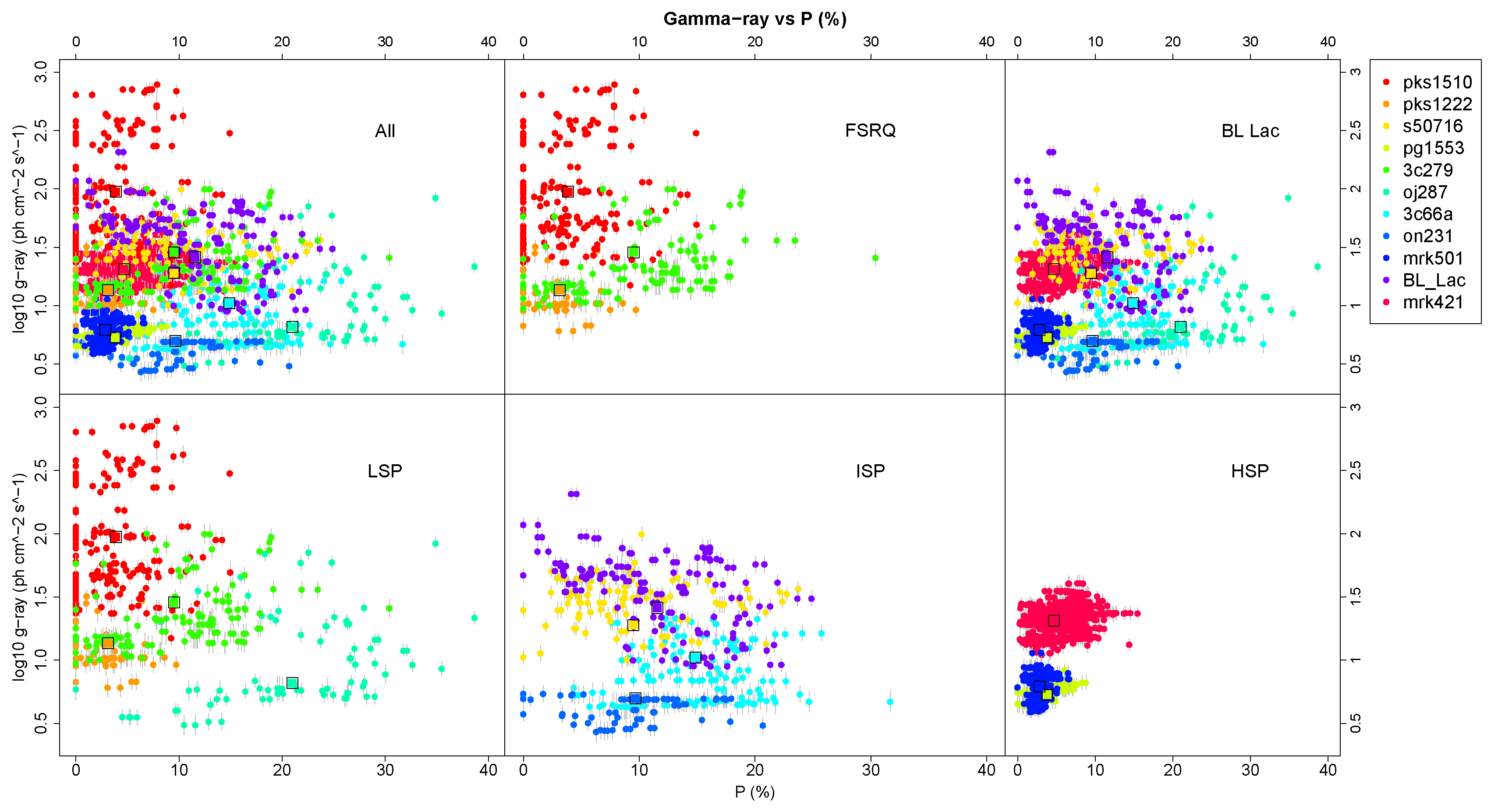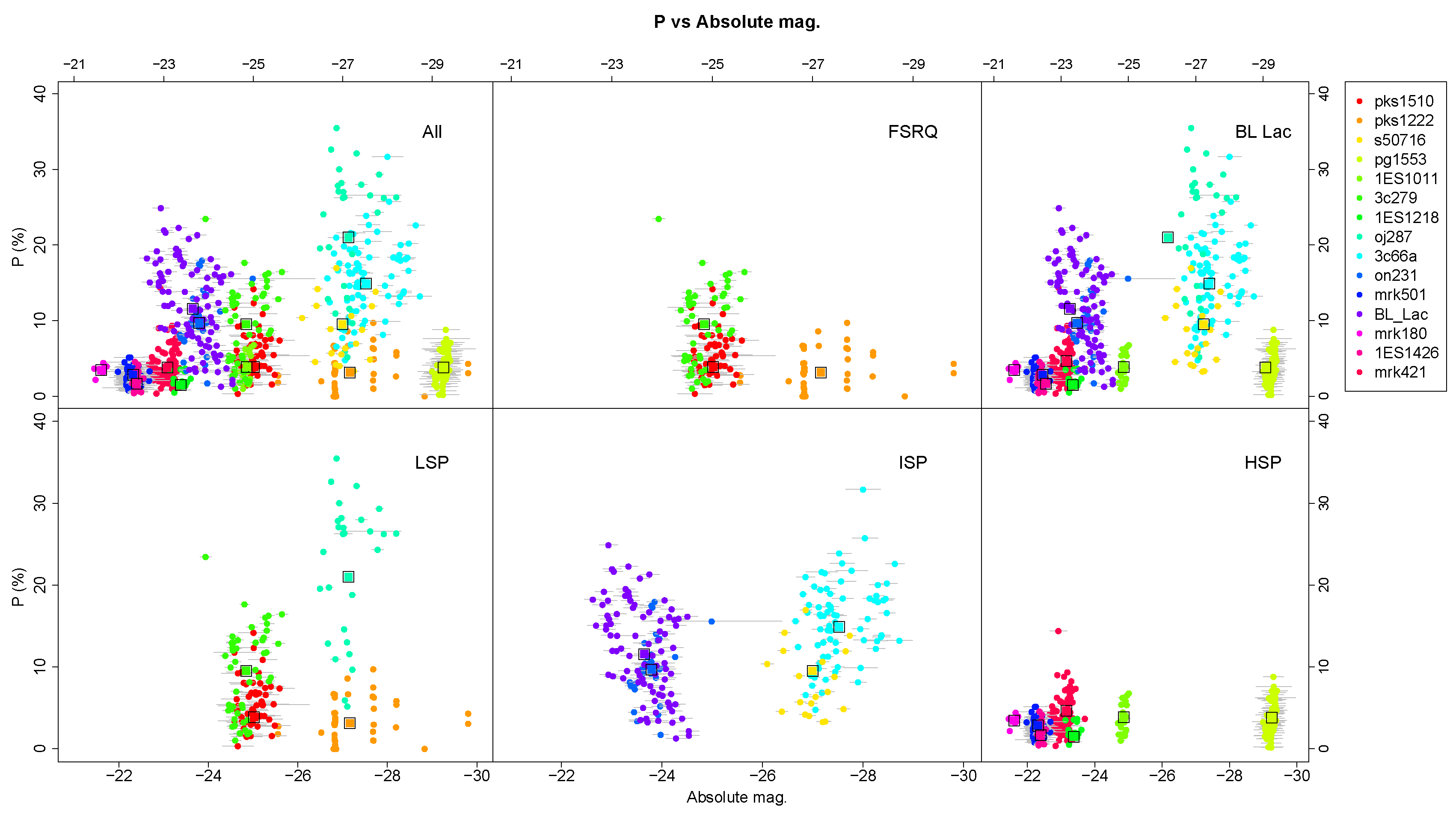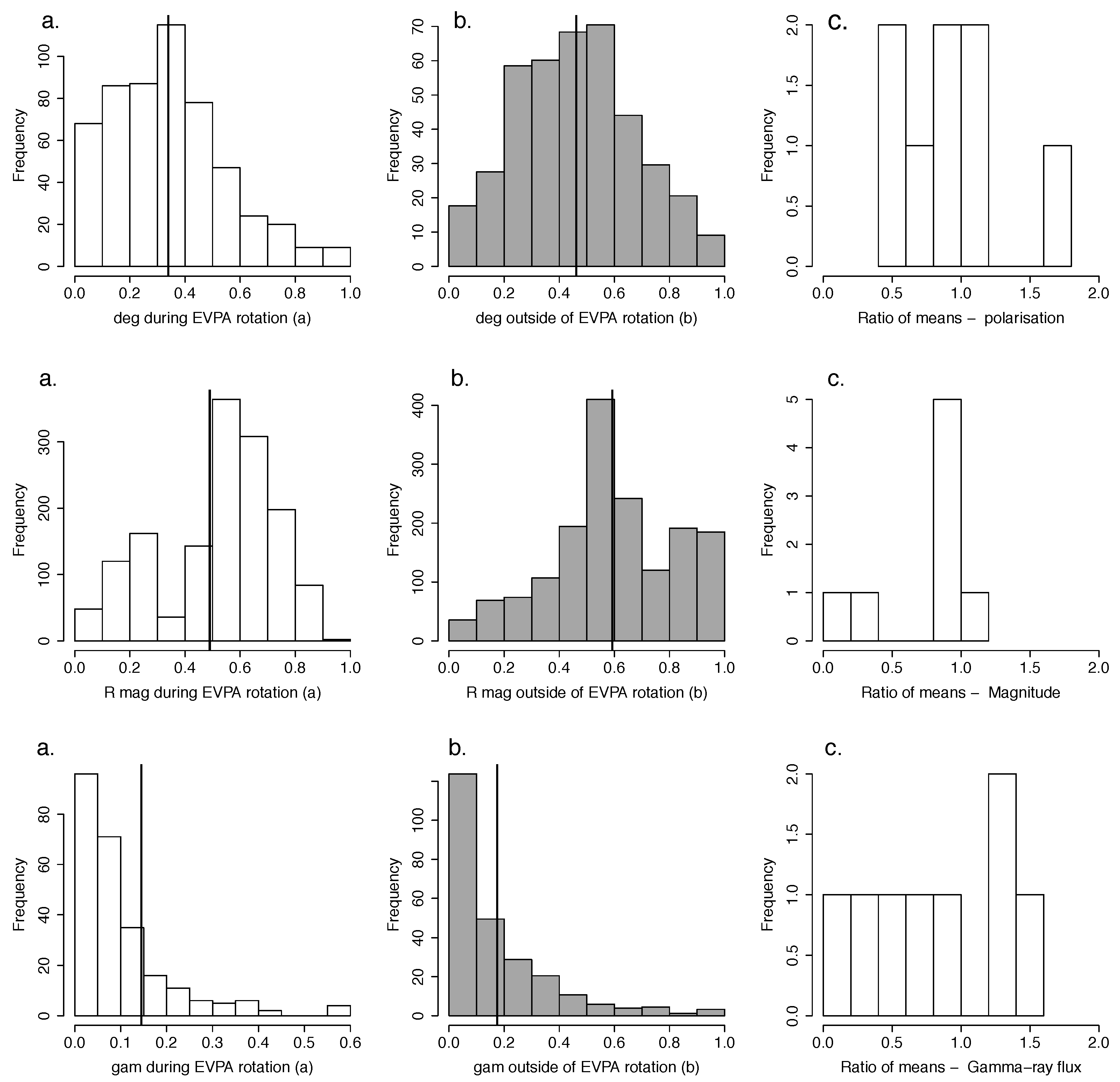Ringo2 Optical Polarimetry of Blazars
Abstract
:1. Introduction
2. Results
2.1. Optical and γ-ray Flux Correlations
2.2. Optical Degree of Polarisation and γ-ray Flux Correlations
2.3. Absolute Magnitude and Degree of Polarisation Correlations
3. Optical and γ-ray Properties during EVPA Rotations
4. Conclusions
- (1)
- The maximum observed degree of optical polarisation for the LSP sources was %. For ISP sources it was ∼30% and for HSP sources ∼10% (similar to the findings of [10]). It is natural to attribute the low maximum polarisation degree in HSP sources to their optical light being dominated by non-synchrotron emission which could originate from the accretion disk, host galaxy or emitting regions outside of the jet. [11], however, suggested that the lower polarisation values observed in the HSP sources cannot be completely explained by host galaxy emission. The lack of emission lines with equivalent widths >5 Å in BL Lac-type objects (HSP, ISP and LSP alike), suggests a very-low luminosity accretion disk in these sources (e.g., [12]). This means that dilution of the polarised light is unlikely to be caused by contribution from the accretion disk and the likely cause of the low levels of polarisation is a low ordered magnetic field in the jet. It must also be noted that, due to the biased nature of this sample, these results cannot be applied to the larger blazar population.
- (2)
- On average the optical degree of polarisation and γ-ray flux are not strongly correlated. ISP and LSP sources show no strong preference for either positive or negative correlations. HSP sources show a stronger (yet still weak) positive correlation.
- (3)
- In 92% (34/37) of source seasons we found a positive correlation ( = 0.37) between optical and γ-ray flux. In over half of the seasons (25/37 = 68%) the probability of correlation is significant (i.e., p ≤ 0.05). Similar findings have also been reported by [13] and [14]. This may suggest a close physical association between the optical and γ-ray emitting regions in blazars.
- (4)
- There is a weak () correlation between optical flux and degree of polarisation in 13/15 source seasons. In 5/15 cases the probability of correlation ( = 0.25) is significant (i.e., p≤ 0.05).
- (5)
- All blazar subclasses show γ-ray flaring and θ rotations.
- (6)
- The mean degree of polarisation as a percentage of the total range of polarisation is 26% lower during periods of rotation compared to periods of non-rotation; [15] also report a decrease in polarisation during rotations. The mean optical flux is 17% lower during a rotation compared with outside rotations and the mean γ-ray flux is 41% lower during a rotation compared with outside a rotation. There is an additional caveat to note here, whereby the gaps in the observed data result in a loss of information about the behaviour of the EVPA. To sufficiently solve this problem, long term, continual monitoring would be required. The lower degree of polarisation during a rotation can be interpreted as a difference in the degree of ordering of the magnetic field during a rotation compared with non-rotation. Alternatively it could be evidence for their association with emission features or shocks travelling along helical magnetic field lines [16,17].
Acknowledgments
Author Contributions
Conflicts of Interest
References
- Kikuchi, S.; Mikami, Y.; Inoue, M.; Tabara, H.; Kato, T. A synchronous variation of polarization angle in OJ 287 in the optical and radio regions. Astron. Astrophys. 1988, 190, L8–L10. [Google Scholar]
- Steele, I.A.; Smith, R.J.; Rees, P.C.; Baker, I.P.; Bates, S.D.; Bode, M.F.; Bowman, M.K.; Carter, D.; Etherton, J.; Ford, M.J.; et al. The Liverpool Telescope: performance and first results. In Ground-Based Telescopes; Oschmann, J.M., Jr., Ed.; SPIE: Bellingham, WA, USA, 2004; Volume 5489, pp. 679–692. [Google Scholar]
- Steele, I.A.; Bates, S.D.; Guidorzi, C.; Mottram, C.J.; Mundell, C.G.; Smith, R.J. RINGO2: An EMCCD-based polarimeter for GRB followup; SPIE: Bellingham, WA, USA, 2010; Volume 7735. [Google Scholar]
- Piirola, V.; Berdyugin, A.; Mikkola, S.; Coyne, G.V. Polarimetric Study of the Massive Interacting Binary W Serpentis: Discovery of High-Latitude Scattering Spot/Jet. Astrophys. J. 2005, 632, 576–589. [Google Scholar] [CrossRef]
- Clarke, D.; Neumayer, D. Experiments with a novel CCD stellar polarimeter. Astron. Astrophys. 2002, 383, 360–366. [Google Scholar] [CrossRef]
- Simmons, J.F.L.; Stewart, B.G. Point and interval estimation of the true unbiased degree of linear polarization in the presence of low signal-to-noise ratios. Astron. Astrophys. 1985, 142, 100–106. [Google Scholar]
- Jermak, H.; Steele, I.A.; Lindfors, E.; Hovatta, T.; Nilsson, K.; Lamb, G.P.; Mundell, C.; Barres de Almeida, U.; Berdyugin, A.; Kadenius, V.; et al. The RINGO2 and DIPOL Optical Polarisation Catalogue of Blazars. Mon. Not. Roy. Astron. Soc. 2016, 462, 4267–4299. [Google Scholar] [CrossRef]
- Lott, B.; Escande, L.; Larsson, S.; Ballet, J. An adaptive-binning method for generating constant-uncertainty/constant-significance light curves with Fermi-LAT data. Astron. Astrophys. 2012, 544, A6. [Google Scholar] [CrossRef]
- Blinov, D.; Pavlidou, V.; Papadakis, I.; Kiehlmann, S.; Panopoulou, G.; Liodakis, I.; King, O.G.; Angelakis, E.; Baloković, M.; Das, H.; et al. RoboPol: First season rotations of optical polarization plane in blazars. Mon. Not. Roy. Astron. Soc. 2015, 453, 1669–1683. [Google Scholar] [CrossRef]
- Smith, P.S.; Williams, G.G.; Schmidt, G.D.; Diamond-Stanic, A.M.; Means, D.L. Highly Polarized Optically Selected BL Lacertae Objects. Astrophys. J. 2007, 663, 118–124. [Google Scholar] [CrossRef]
- Jannuzi, B.T.; Smith, P.S.; Elston, R. The optical polarization properties of X-ray-selected BL Lacertae objects. Astrophys. J. 1994, 428, 130–142. [Google Scholar] [CrossRef]
- Cavaliere, A.; D’Elia, V. The Blazar Main Sequence. Astrophys. J. 2002, 571, 226–233. [Google Scholar] [CrossRef]
- Hovatta, T.; Pavlidou, V.; King, O.G.; Mahabal, A.; Sesar, B.; Dancikova, R.; Djorgovski, S.G.; Drake, A.; Laher, R.; Levitan, D.; et al. Connection between optical and γ-ray variability in blazars. Mon. Not. Roy. Astron. Soc. 2014, 439, 690–702. [Google Scholar] [CrossRef]
- Cohen, D.P.; Romani, R.W.; Filippenko, A.V.; Cenko, S.B.; Lott, B.; Zheng, W.; Li, W. Temporal Correlations between Optical and Gamma-Ray Activity in Blazars. Astrophys. J. 2014, 797, 137. [Google Scholar] [CrossRef]
- Blinov, D.; Pavlidou, V.; Papadakis, I.E.; Hovatta, T.; Pearson, T.J.; Liodakis, I.; Panopoulou, G.V.; Angelakis, E.; Baloković, M.; Das, H.; et al. RoboPol: optical polarization-plane rotations and flaring activity in blazars. Mon. Not. Roy. Astron. Soc. 2016, 457, 2252–2262. [Google Scholar] [CrossRef]
- Marscher, A.P.; Jorstad, S.G.; D’Arcangelo, F.D.; Smith, P.S.; Williams, G.G.; Larionov, V.M.; Oh, H.; Olmstead, A.R.; Aller, M.F.; Aller, H.D.; et al. The inner jet of an active galactic nucleus as revealed by a radio-to-γ-ray outburst. Nature 2008, 452, 966–969. [Google Scholar] [CrossRef] [PubMed]
- Zhang, H.; Deng, W.; Li, H.; Böttcher, M. Polarization Signatures of Relativistic Magnetohydrodynamic Shocks in the Blazar Emission Region—I. Force-free Helical Magnetic Fields. Astrophys. J. 2015, 817, 63. [Google Scholar] [CrossRef]




| Name | z | Type | R Mag. Range | Pol. Range (%) | Fermi Range (ph·cm·s) | Observation Period (MJD) |
|---|---|---|---|---|---|---|
| 3C 66A | 0.444 | ISP | 15.1–13.2 | 1.0–27.7 | 4.0 × 10–1.1 × 10 | 55413.17–56226.03 |
| S5 0716+714 | 0.31 | ISP | 14.4–12.2 | 0.3–23.7 | 6.4 × 10–1.3 × 10 | 55651.86–56035.00 |
| OJ 287 | 0.306 | LSP | 15.4–13.5 | 4.5–38.7 | 2.8 × 10–1.4 × 10 | 55641.91–56223.22 |
| 1ES 1011+496 | 0.212 | HSP | 15.6–14.7 | 0.8–6.8 | 4.2 × 10–9.7 × 10 | 56006.93–56094.92 |
| Mrk 421 | 0.031 | HSP | 13.0–12.0 | 0.2–8.8 | 1.0 × 10–1.3 × 10 | 55705.90–56096.89 |
| Mrk 180 | 0.045 | HSP | 15.5–15.1 | 2.5–5.1 | ... | 56006.89–56216.24 |
| 1ES 1218+304 | 0.164 | HSP | 16.0–15.5 | 0.6–4.3 | 1.6 × 10–2.6 × 10 | 56065.88–56136.90 |
| ON 231 | 0.102 | ISP | 15.6–14.1 | 0.6–23.3 | 2.3 × 10–8.6 × 10 | 55573.26–56032.97 |
| PKS 1222+216 | 0.432 | LSP | 15.8–14.7 | 0.5–9.7 | 8.6 × 10–1.3 × 10 | 55901.24–55935.16 |
| 3C 279 | 0.536 | LSP | 17.8–14.3 | 1.3–36.0 | 1.2 × 10–2.7 × 10 | 55575.29–56101.94 |
| 1ES 1426+428 | 0.129 | HSP | 16.3–15.7 | 0.4–5.2 | ... | 56047.00–56171.87 |
| PKS 1510-089 | 0.36 | LSP | 16.6–13.1 | 0.5–16.5 | 2.6 × 10–2.1 × 10 | 55575.30–56062.09 |
| PG 1553+113 | <0.78 | HSP | 14.0–13.1 | 0.2–9.1 | 4.2 × 10–1.0 × 10 | 56007.13–56171.87 |
| Mrk 501 | 0.034 | HSP | 13.3–12.5 | 0.8–6.6 | 3.9 × 10–1.4 × 10 | 55660.04–56136.89 |
| BL Lac | 0.069 | ISP | 15.0–12.7 | 1.2–27.3 | 10.0 × 10–1.5 × 10 | 55413.11–56225.94 |
| All P | p ≤ 0.05 | ||||||||||
|---|---|---|---|---|---|---|---|---|---|---|---|
| Type | Range p | Range ρ | Mean
p | Mean
ρ | Quantity -ρ, +ρ | Quantity | Range ρ | Mean ρ | Quantity -ρ, +ρ | Quantity | |
| mag-gam | HSP | 2.20 × 10–0.620 | −0.0929–0.745 | 0.210 | 0.299 | 1, 6 | 7 | 0.502–0.745 | 0.608 | 0, 3 | 3 |
| ISP | 4.97 × 10–0.524 | −0.067–0.718 | 0.115 | 0.429 | 0, 16 | 16 | 0.287–0.718 | 0.567 | 0, 10 | 10 | |
| LSP | 0.000–0.988 | −0.600–0.711 | 0.141 | 0.337 | 2, 12 | 14 | −0.600–0.711 | 0.390 | 2, 10 | 12 | |
| ALL | 0.000–0.988 | −0.600–0.745 | 0.142 | 0.369 | 3, 34 | 37 | −0.600–0.745 | 0.487 | 2, 23 | 25 | |
| gam-deg | HSP | 1.89 × 10–0.419 | −0.121–0.633 | 0.196 | 0.231 | 1,4 | 5 | 0.160–0.633 | 0.397 | 0, 2 | 2 |
| ISP | 6.68 × 10–0.946 | −0.560–0.411 | 0.370 | −0.0382 | 8,8 | 16 | −0.560–0.272 | −0.229 | 2, 1 | 3 | |
| LSP | 1.52 × 10–0.925 | −0.249–0.556 | 0.340 | 0.0619 | 6, 5 | 11 | 0.360–0.556 | 0.426 | 0, 3 | 3 | |
| ALL | 1.89 × 10–0.946 | −0.560–0.633 | 0.332 | 0.038 | 15, 17 | 32 | −0.560–0.633 | 0.173 | 2, 6 | 8 | |
| deg-mag | HSP | 1.98 × 10–0.695 | 0.0876–0.549 | 0.312 | 0.268 | 0, 7 | 7 | 0.468–0.513 | 0.525 | 0, 2 | 2 |
| ISP | 1.53 × 10–0.0754 | −0.485–0.395 | 0.0212 | 0.0334 | 2, 2 | 4 | −0.460–0.403 | 0.0697 | 1, 2 | 3 | |
| LSP | 0.0607–0.999 | 5.47 × 10–0.270 | 0.472 | 0.154 | 0, 4 | 4 | NA | NA | NA | 0 | |
| ALL | 1.53 × 10–0.999 | −0.485–0.549 | 0.277 | 0.175 | 2, 13 | 15 | −0.460–0.513 | 0.252 | 1, 4 | 5 |
© 2016 by the authors; licensee MDPI, Basel, Switzerland. This article is an open access article distributed under the terms and conditions of the Creative Commons Attribution (CC-BY) license (http://creativecommons.org/licenses/by/4.0/).
Share and Cite
Jermak, H.; Steele, I.; Lindfors, E.; Hovatta, T.; Nilsson, K.; Lamb, G.; Mundell, C.; Barres De Almeida, U.; Berdyugin, A.; Kadenius, V.; et al. Ringo2 Optical Polarimetry of Blazars. Galaxies 2016, 4, 52. https://doi.org/10.3390/galaxies4040052
Jermak H, Steele I, Lindfors E, Hovatta T, Nilsson K, Lamb G, Mundell C, Barres De Almeida U, Berdyugin A, Kadenius V, et al. Ringo2 Optical Polarimetry of Blazars. Galaxies. 2016; 4(4):52. https://doi.org/10.3390/galaxies4040052
Chicago/Turabian StyleJermak, Helen, Iain Steele, Elina Lindfors, Talvikki Hovatta, Kari Nilsson, Gavin Lamb, Carole Mundell, Ulisses Barres De Almeida, Andrei Berdyugin, Ville Kadenius, and et al. 2016. "Ringo2 Optical Polarimetry of Blazars" Galaxies 4, no. 4: 52. https://doi.org/10.3390/galaxies4040052
APA StyleJermak, H., Steele, I., Lindfors, E., Hovatta, T., Nilsson, K., Lamb, G., Mundell, C., Barres De Almeida, U., Berdyugin, A., Kadenius, V., Reinthal, R., & Takalo, L. (2016). Ringo2 Optical Polarimetry of Blazars. Galaxies, 4(4), 52. https://doi.org/10.3390/galaxies4040052







